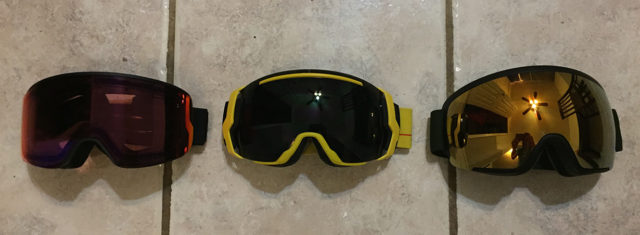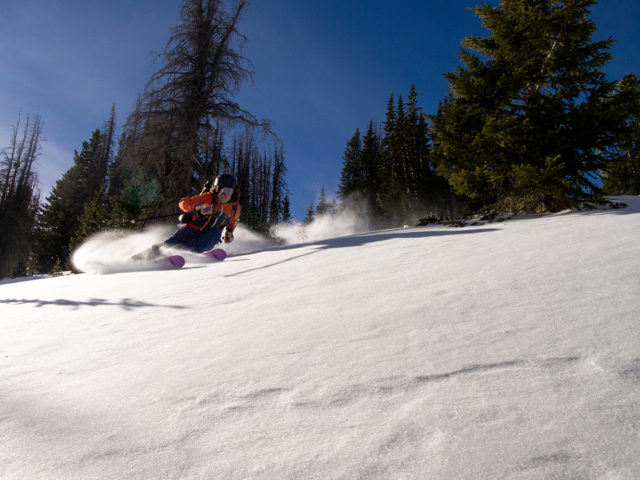Frame Color: Black Bar
Lenses Tested:
- Vivid Onyx (14% VLT)
- Vivid Infrared (62% VLT)
Stated Features:
- EVAK vent technology
- Triple-layer face foam with microfleece facing
- Anti-fog coating
- OTG friendly
- Medium size EXV frameless design
- Quick Change magnetic-assisted lens system
- Injection-molded cylindrical VIVID Lenses with Optics by ZEISS
MSRP: $180
Test Locations: Revelstoke Mountain Resort, Sunshine Village, Lake Louise Ski Resort, & Rogers Pass, BC; Cameron Pass & Rocky Mountain National Park, CO
Days Tested: ~15
Intro
If you’ve been keeping an eye on the major goggle manufacturers recently, many brands are now offering some sort of new lens line that claims to increase contrast and versatility in variable light conditions. Giro’s offering in this category is a new line of lenses made in partnership with the venerable Swiss optics manufacturer, ZEISS, which Giro is calling “VIVID.”
One of the goggles to feature these new lenses is Giro’s cylindrical Axis. With a magnetic lens swap system, upper and lower vents, and two VIVID lenses included with the goggle, Giro is claiming the Axis is “ready for all aspects, conditions, and every element.”
I’ve had the chance to test the Axis in everything from blinding Colorado sun to a week of overcast storm skiing in British Columbia, and here’s what I’ve found:
Fit
Giro calls the fit of the Axis “medium,” and based on my experience with other goggles, I think that’s pretty accurate. I have a pretty big head, and the Axis fits me comfortably (though it’s maybe a tiny bit smaller than what I’d personally prefer).
Compared to the Smith I/O7, the Axis is a touch narrower across the face, and has a slightly flatter upper edge. Compared to the POC Orb Clarity (review coming soon), the Axis is smaller all-around.

Lens Swapping
The Axis has a very intuitive lens swap system consisting of magnets and 4 snaps. The left side of the goggle has a slight indent in the frame where you can get the tip of your finger (or mitten) under the lens and pry it off. I spend most of my time skiing with mittens, and I haven’t had any trouble getting the Axis’ lens on and off while wearing them.
When it comes to putting the lens back on, the process isn’t quite as easy as the Anon M2 (you can’t just throw the goggle in the general direction of your face and expect the magnets to suck it in). However, after just a few times swapping lenses with the Axis, I was able to quickly change the lenses while keeping the goggles on my head. The magnets help you locate where the snaps are supposed to go, and then once aligned, pushing the snaps in provides a reaffirming “click.”
Compared to the lens swap system on the Smith I/O7, the Axis is significantly quicker, easier, and you can swap lenses without taking your goggles off. This is great if you’re like me and often ski with your goggles under your helmet. Compared to the Anon M2 and Giro Contact, the Axis isn’t quite as easy to swap, but I have been perfectly happy with the Axis’ system.
Lenses and VIVID Technology
Giro claims that their VIVID lenses provide more contrast in all snow conditions compared to traditional goggles. While using the two lenses included with the Axis I tested, I noticed a slight increase in the contrast provided by both VIVID lenses compared to the lenses I’ve used from Smith and POC. The difference wasn’t extreme, but it was noticeable. More on the individual lenses below:
VIVID Onyx (14% VLT)
The VIVID Onyx lens is the sun / all-conditions lens that comes with the “Black Bar” frame of the Axis I tested. My previous sunny lens had been the Smith Blackout (10% VLT), which was great for super bright days, but did not provide a lot of contrast and could be a bit unnerving when the clouds rolled in. While the VIVID Onyx has provided plenty of shade during bluebird days, it also does decently well when it’s not extremely bright outside. That said, the VIVID Onyx lens is not quite as versatile as the photochromatic Spektris Gold lens on the POC Orb Clarity (stated VLT of 18-43%).

VIVID Infrared (62% VLT)
The VIVID Infrared lens has performed very well in low-light conditions. Even during some very dark and stormy days up in BC, I never had a problem with visibility. Compared to the Smith Photochromatic Red Sensor lens (VLT 20-50%), the VIVID Infrared worked much better in overcast conditions and provided better contrast. Compared to the POC Spektris Gold lens, the VIVID Infrared was definitely better in low light, but not as versatile when the sun came out.

Fogging
When taken care of properly (i.e. making sure to dry out lenses after a day of skiing and keeping snow out of them), I haven’t had any unusual problems with fogging while using the Axis. I’ve never been able to wear goggles for very long while skinning without them fogging up, and the Axis wasn’t an exception. It didn’t blow me away with it’s anti-fogging capabilities, but it also didn’t perform any worse than other goggles I’ve used.
I’ve been using the Axis with Giro’s Combyn helmet, and the Combyn’s vents line up nicely with the Axis’ upper vents. I’ve found that after I work up a sweat, the Axis / Combyn pairing does a good job of venting once I start heading downhill (as long as there isn’t any snow caked over the vents).
Field of View
The Axis provides a pretty wide field of view (wider than the Smith I/O7), and I have been perfectly happy with how much I can see while wearing the Axis. Even when compared to the larger, spherical POC Orb Clarity, I didn’t notice a major difference between the two in terms of field of view.

While some people complain about cylindrical goggles’ peripheral distortion, I haven’t noticed this with the Axis (though I’ve never really noticed this with any cylindrical goggles).
Helmet Compatibility
As I noted earlier, I’ve been using the Axis in coordination with Giro’s Combyn. This helmet / goggle combination works very well, virtually eliminating any sort of gaper gap and venting effectively. We’ll be posting our full review of the Combyn very soon.
Durability
After about 15 days, I haven’t noticed any durability issues with the Axis. The lenses are surprisingly lacking in scratches (which is impressive since I’m not very careful when it comes to taking care of lenses). The strap is still holding its tension, and the lens swap system continues to work flawlessly.
Price
The MSRP of the Axis is $180, which, when you take into account its feature set, is a pretty competitive price. Some other goggles with magnetic lens swap systems are significantly more expensive: Giro’s Contact comes in at $250; Zeal’s Portal is $269; and the Anon M3 costs between $229 and $289 (depending on the lenses).
In addition to the easy lens swap system, the Axis comes with two quality lenses, which make its relatively low price even more impressive.
Bottom Line
The Giro Axis has an easy and secure lens swap system, includes great lens options, vents effectively, and comes in at a competitive price. If you like the semi-frameless cylindrical design and the Axis fits your face and helmet, I’d highly recommend it.


Smith Blue Sensor is gold standard for versatile low-light lens. Tint is better than Red Sensor for storm day contrast & at 60% VLT it’s much closer apples-to-apples w/ the lighter Giro lens. Direct comparison would be Ilkuminating, especially for those who don’t like the fit of Smith’s newer medium-sized frames since they stopped making the Phenom/Phase.
Hi Matteo,
Thanks for reaching out. We are definitely hoping to compare the Giro VIVID Infrared to other, more apples-to-apples low-light lenses, so we hope to have an update on that this season.
Best,
Luke
Matteo, you may be interested in the new Smith I/O Mag (magnetic) coming out for next season which a buddy who has them swears they fit like the Phenoms.
Thx. Will keep an eye out. For my needs, the entire I/O series has been a step backwards in fit & function (I/O strap anchor designs mate poorly w/ my face inside 2 Smith helmets & ginormous lens coverage area increases fogging vs. “goldilocks” sizing of Phenom). A return to the Phenom fit is something I’d definitely want to check out though.
Can you tell me what the distinction is between this and the axis AF? it seems like most giro goggles include an AF designated counterpart. Thanks!
I was actually wondering that myself, and have reached out to Giro to clarify. I’ll respond as soon as I hear back from them.
Just heard back — “AF” stands for “Asian Fit.” Essentially, this means more foam padding around the nose to create a better seal for people with lower-profile / smaller noses. So for people with small noses who often get a gap between their nose and the foam of regular-fit goggles, the “AF” versions might be worth a look.
Thanks Luke! Pretty weird that Giro doesn’t specify that anywhere. Good info to know.